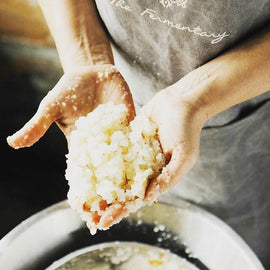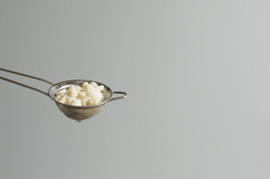How to
- Peel the beetroots and grate them. If the skins are lovely and fine- give them a hearty scrub and don't bother with peeling. Alternatively, top and tail them and instead of grating, you could cut into thin rounds, and jar them with a brine. But here to save from shredding you could stack them and then slice that stack very finely to a julienne. Sometimes that is the cleaner way to do it and thicker pieces ferment a bit crunchier.
- Chop or grate the cabbage very finely.
- Combine the beetroot and cabbage, weigh to work out your salt (you’ll want 1.5-2% weight of salt to cabbage/beet mix),
- In a large bowl or container add the salt mixing it through very well. Leave to sit for a good 20 minutes to get as much juice as possible.
- Check if it's moving along well, by grabging a handful and squeezing tightly – hopefully you’ll have juices running out, but If you don’t then you may need to massage or pound the beets and cabbage until that happens. (Or let them sit a bit longer). A bit of a massage is cathartic and good to do anyway, I'm just trying to save you from staining your hands.
- Chop shallots finely and mixing them in.
- Add the seeds, horseradish* and pepper
- Combine well, really mixing in with your hands making sure the horseradish is distributed well.
- Jar well, leaving no gaps or air bubbles, pushing down tightly as you go and leaving head room as well.
- Weigh the cabbage down - first adding a spare leaf to the top and then pop something on top of that to keep the kraut under.
- Sit at room temperature, out of light and ferment for 10 days - taste to see if you like it. If it's ready then take out the weights and leaf, lid again - and pop into fridge. It will last there for months.
Note:
*Grating horseradish - peel the tough, woody outside with a knife or vegetable peeler, but beware! Horseradish can make you cry and sting more than onions. Make sure your room is ventilated before you begin. If you've bought a root - grate the whole thing and make a preserved horseradish with it while you wait for the cabbage to get juicy.
The sugar is higher in this remember, so an air lock system is good - if not you'll need to burp your jar, and sit in on a dish.
Always leave a nice inch or two headroom – enough to leave room in the jar after you’ve lined the top with a cabbage leaf and a weight.
*if buying prepared horseradish look for one with the fewest additives.
Ingredients
- 2 beetroots about 300g
- 1 green or red cabbage (approx. 1kg, save the red for another ferment - as the green will go red anyway)
- 30 g salt
- 2 peeled shallots – anyway you’d like – sliced thinly, or in half or even left whole
- 1 tablespoon dill seeds,
- 1 large fresh dill frond
- 3 tablespoons (or to taste) fresh horseradish, minced (if fresh is hard to come by, prepared is OK)*
- 1 tablespoon ground black pepper
Horseradish has long been used as an immune booster, for urinary tract infections, to enhance digestion, fight inflammation and help with respiratory conditions. The list goes on and I think it's something, like mustard seeds, that we should be eating more of.
Find similar articles
Fermented Vegetables

